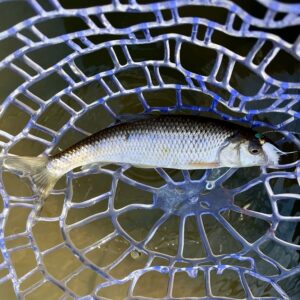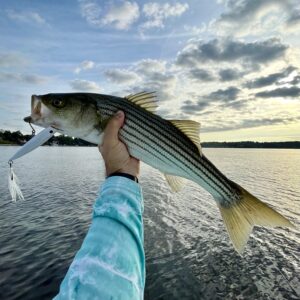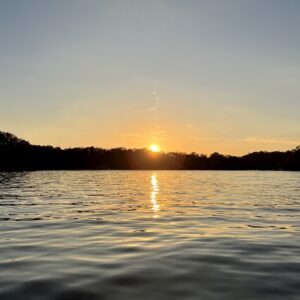Welcome to Reel Chesapeake’s Weekly Fishing Report, our interpretation of what’s biting and where throughout the Chesapeake Bay watershed. Please email us directly at editor@reelchesapeake.com to share updates and photographs of your recent catches for potential inclusion in next week’s column. The leading photograph (above): Stringer of 10” class white perch taken in a Severn River creek on Tuesday, July 18th by yours truly.
With the two-week striped bass moratorium in effect throughout Maryland’s portion of the Chesapeake Bay (through 7/31), anglers are focused on other species…or working on their vessels…or taking a midsummer break altogether.
White perch are one of the great species abundant throughout the Bay and all its tributaries. If taking home a stringer of these delectable beauties—known for their firm, clean, white filets—is appealing to you, then now is a perfect time to do so. Summer is peak season to load up on them, and even fill the freezer. Finding and catching them should be predictable and fairly easy.
In many rivers, especially the mid-Bay tribs, expect to find white perch picking off tiny minnows and insects off the topwater at sunrise and sunset in feeder creeks. Ambitious anglers may try their hand at fly casting to them with creatures and insects on light, 3-weight outfits. Or, perhaps, with an indicator and a tiny feather fly tied 12–18” below it (basically a float/fly-type setup). The action could be nonstop if you find a feeding school.

Light, fast-action spinning outfits will undoubtedly be in many anglers hands and are especially effective at catching perch when casting a variety of 1/16 to 1/4oz lures along shaded shorelines, around docks, or any type of structure in moving water. On Tuesday morning, I visited a Severn River creek with a particular eastern shoreline that remained shaded all morning. The stretch was littered with laydowns in a 3’ to 7’ zone. Perch were everywhere, and picking off a stringer of 10-inchers made for an exciting morning (and tasty dinner). I used a 1/8oz jighead tipped with a 2” micropaddletail. And the bycatch was very interesting—several juvie bluefish, a pickerel, and a couple striped bass up to 17” (released in water).
If you’re aiming for white perch in the Bay proper, try structure areas like the bridge, Sandy Point jetties, Thomas Point Lighthouse, the Choptank airplane wreck, Calvert Cliffs Nuclear Power Plant, the Gas Docks, and any oyster bars/reefs mapped out. Check for historical oyster reefs at Maryland Department of Natural Resources, here. Artificial reefs, many created in partnership with Coastal Conservation Association Maryland, also attract the fish. Learn about the Living Reef Action campaign, here.
We’re also hearing more reports of bluefish working their way toward the middle Chesapeake. If the juvies that we recently caught are any indication, this week into next should see more anglers targeting the fish from the Bay Bridge south to Poplar Island and beyond. Ditto for the mid-bay Spanish mackerel run, which seems to be a week or so behind schedule. Regardless, now is the time to give both a shot by speed-trolling #1 or #2 planers with metallic spoons at 7–9 mph. You can also try casting those same spoons or rain minnow lures and retrieving them as fast as you can to attract strikes.
For a bigger fish bite, largemouth bass and northern snakehead offer excellent action and can be found in many Chesapeake bodies. The Marshyhope on Maryland’s Eastern Shore—a branch of the Nanticoke River—has a healthy population of 2–3 pounders. Big, 7” or 9” ribbon tail worms rigged Tex-style have been pulling them in. Similarly, the Pocomoke has offered bassmasters consistent action.
The Potomac watershed and its many creeks—particularly the Mattawoman, Pomonkey, and Piscataway—also hold bass upwards of 6-pounds, plus plenty of northern snakehead, including dragons. Topwater frogs and chatter-style baits are two primary lures to try. The Jug Bay vicinity within the Patuxent River is also prime territory for both species.
Smallmouth bass fishing has also been gaining attention of anglers in the northern and central regions of the watershed. Fast flowing creeks and rivers in the northern Potomac, Middle and Little Patuxent, and upper Patapsco offer shallow, boulder strewn runs and holes where smallmouth will readily pounce on small grubs, stingers, and the like. The Susquehanna River, north of Conowingo Dam, also offers excellent smallmouth fishing (and in the dam pool below, try chunking for blue catfish!).
And, of course, the biggest bay bites of all are bull reds and cobia in the southern waters from Point Lookout to the mouth of the Chesapeake near Cape Charles. Savvy anglers are targeting shallow grass flats in Tangier Sound for reds with jig/paddletail combos, while running, gunning, and sight-fishing for cobia in more open water is what it takes to hunt the bigguns. Good luck!
This report appears within On The Water magazine’s weekly collection of Chesapeake Bay fishing reports.





